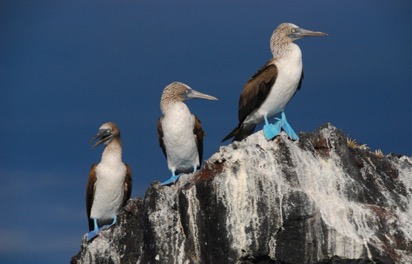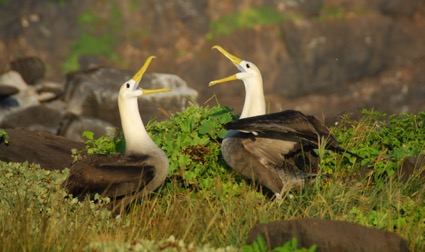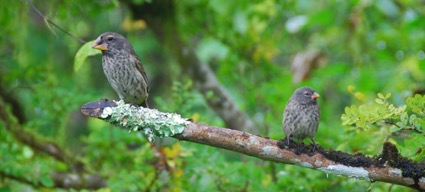By: Luis Die Dejean
Thirty years ago I arrived to the Galapagos for the first time. I had studied evolution extensively in university, I had read every book I could find about the islands so the Darwin finches where as familiar to me as the sparrows at home (or so I thought) and the prospect of seeing strange exotic birds such as penguins, flightless cormorants, boobies or albatross was exciting enough to make me forget that I had really no idea what I was about to experience.
Unlike my native Spain, where seeing a bird meant keeping quite a distance, staying really silent and moving slowly, I quickly discovered to my amazement, that birdwatching in Galapagos was something of a different level. The lack of fear of the local fauna felt almost like a disrespect, something unreal for someone used to carrying binoculars everywhere. The biggest shock for anyone visiting the islands is not the electric blue feet of the boobies, nor the awkward look of a male frigatebird displaying a huge red baloon, not even seeing a penguin basking under a mangrove in the equatorial sun. It’s the tameness of the birds and most other native species.

Blue footed boobies are among the favorite birds for anyone visiting the islands
Sitting right next to a couple of courting albatross and seeing at close range their entire parade without disturbing them, following a cormorant while he forages underwater, observing a booby feeding its chicks a few feet away from you… all of this is something that continues to amaze me even after 30 years and it’s still as wonderful as the first day.
It makes me wonder (or rather, realize) how the natural world was before we humans expanded and reached every single corner of this planet. Most birds probably didn’t have an ancestral fear to humans as we don’t look at all like their traditional predators. But throughout the world, they surely learned quickly the hard way that Homo sapiens can be a really mean creature. Not in the Galapagos where humans where absent until very recently.

Waved albatrosses courting at Española islands.
As you wander through the trails looking for birds, you quickly realize it is not just about seeing the bird (that’s pretty easy here anyway), but about observing them. Their lack of fear means that you can relax and see what a bird really does in their normal life: how they feed, how they fight, how they try to look beautiful, how they roll their eggs to warm them evenly, how they build their delicate nests, how they feed their chicks… and many other little details and behaviors which define the life of a bird. All that information you normally have to read in books or scientific papers is right there, before your eyes. And then you realize that birds don’t read books, as when you think you know them very well, when you assume you are familiar with their most intimate behaviors, they still surprise you by doing something new, something they are not supposed to do.

Not all the Darwin finches are as easy to identify as this two. Large and small Ground finches are quite different, but many species are surprisingly difficult to tell apart.
And if you are a serious birdwatcher who want some challenges, don’t you worry as we have the Darwin finches. Seventeen of them, many of which can be incredibly hard to identify. Aside from their importance as being the birds which probably inspired Darwin, they still are being studied by scientists and helping us to understand how evolution works and how the world we know came to be the way it is now.
Enjoy your birds !!!